Pulsed power is an exciting and emerging technology with a variety of industrial and Bioelectrics applications, such as water treatment.
The ability of pulsed power to deliver energy as pulsed electromagnetic waves, plasmas, shock waves, radicals and light, opens up new research challenges and unexplored opportunities for industrial and biomedical applications.
This technology is a multi-disciplinary research field which widely used in different applications and showed great potential in liquid decontamination, food processing, tailings dewatering and facilitating fruit and vegetable growth.
Nanosecond pulsed power technology
Microsecond pulsed power excitation has been used in several applications where significant energy loss and high temperature have negatively affected the system performance; thus, this old technique has not been commercialised in industrial or Bioelectrics applications due to these major technical issues.
It is demonstrated that nanosecond pulsed power technology, can improve the efficiency of the systems due to
- less temperature rise and power loss in the medium due to short pulses.
- higher voltage stress across the objects.
- preventing hot plasma in air or liquids.
The state-of-the-art facility at The University of Queensland will enable researchers to explore nanosecond pulsed power excitation in a variety of applications, including mining, food processing, and bioenergy.
What is pulsed power?
Pulsed power technology refers to the generation of high voltage pulses with a narrow pulse width to deliver a huge amount of energy over a short period of time. When electrical energy is stored in a system over a long time and is released over a short time, a huge amount of peak power can be delivered to a load. There are two different types of energies that can create pulsed power signals such as
- switching of voltage (electric field) stored in a capacitor or
- switching of current (magnetic field) stored in an inductor.
As shown below, although the peak power and energy of the generated pulses is very high, for example around a few GW, but the average power can be very low, in the range of watts. Pulsed power parameters and shapes have big impacts on the quality and efficiency of applications.
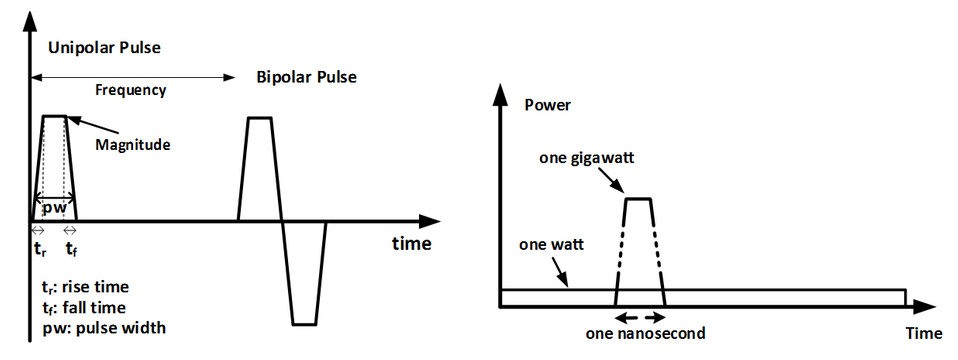
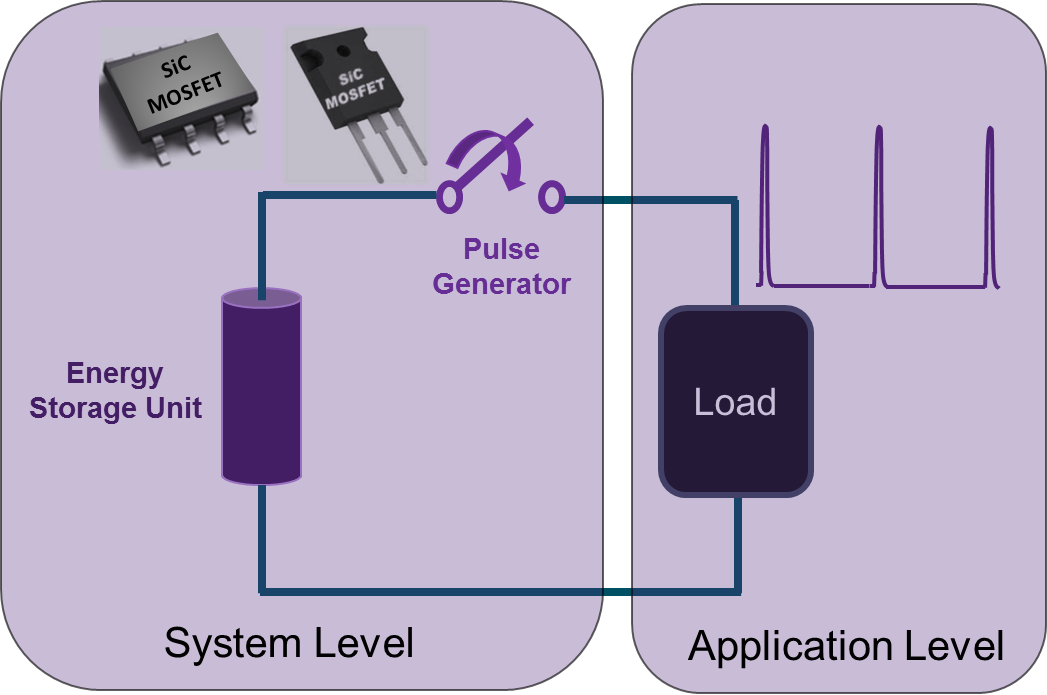
Pulsed power phenomena
When the generated pulses are applied to liquid and gas samples, plasma is produced. Two different types of plasma are usually generated, thermal and non-thermal plasma. The non-thermal plasma is based on chemical and physical reactions and results in biologicals effects and production of some biocidal agents such as electric fields (EFs), reactive chemical species, ultraviolet radiation (UV), heat and shock waves. Several reactive species like OH radicals, ozone, and hydrogen peroxide can be formed in gas-liquid phases in a treatment system when plasma discharges are applied.
With the plasma discharges generated in the liquid phase, physical processes like EFs, shock waves, and UV highly contribute to the biocidal process in addition to chemical effects. The high oxidizing properties of these reactive species make them potential candidates for facilitating the treatment processes.
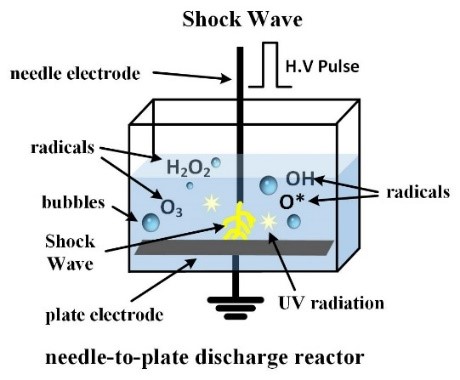
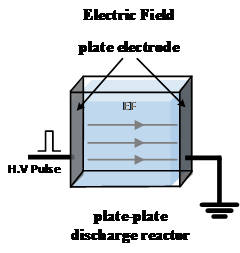
Pulsed power applications
The effect of intense pulsed electric fields on biological cells has been the topic of research since the late 1950s. It has been shown that cells have a capacitive-resistive model and if too much charge gathers at the cell membrane, the electric field breaks the membrane down, creating permeable pores. Specific trains of high voltage pulses can generate reversible or irreversible pores on the membrane, dependent on the electrical characteristics of the pulse and the target organism. This process can be applied to contaminated water to kill bacteria. Studies have indicated that the most important factor in the success of pulsed power water decontamination is the rise time of the pulse, which needs to be as low as nanoseconds. Hence new pulsed power converters are needed for this application to reach its full potential as a safe efficient water decontamination treatment.
Our UQ research team have been developing advanced ultrafast energy conversion systems which can be utilised in several industrial and Bioelectrics applications.
Since 2017, the UQ Nanosecond Pulsed Power research team has been growing significantly in terms of a number of projects and researchers from diverse disciplines, industry partners, grant successes; there is a great potential to establish the first Australian Nanosecond Pulsed Power Research Group in this emerging and innovative research field.
This is a multidisciplinary research field involving many engineering disciplines and fundamental sciences such as physics, chemistry, biology, medical, food and environmental science.
Pulsed Power Research Group and collaborators

Research programs
Advanced pulsed power systems and modelling
Understanding the impact of pulsed power in different applications requires the development of models and simulations, applying the unique physics associated with high power and short duration interactions. This process initiates pore formation, increasing the permeability of the cell membrane through reversible or irreversible electroporation depending on various pulse parameters. The UQ Pulsed Power research team have investigated electromagnetic effects of pulsed power and high voltage in different media using advanced 2D and 3D Finite Element simulation software (ANSYS) in different projects. The impact of these parameters on the spatial distribution of current density and the transmembrane potential was investigated as a function of frequency (1 Hz to 1 GHz).
Compared to spark gap or photoconductive switches used in conventional nanosecond high voltage pulse generators, wide-bandgap power semiconductor devices are used to generate the required high voltage pulses through power converters and are beneficial for reducing the losses and size of the pulse generators.
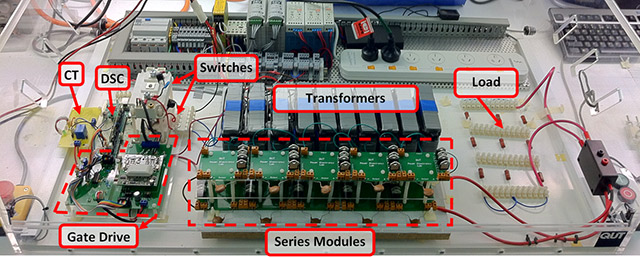
Food processing
Dairy products:
Pulsed Electric Field (PEF) treatment has the great potential to be an alternative to conventional thermal pasteurisation methods. This technology has shown great potential by inactivating a wide range of pathogenic and spoilage microorganisms in food while retaining the desirable components, such as nutrients and enzymes, thus providing consumers with safe and fresh-like food. The UQ Pulsed Power research team have begun investigating nanosecond PEF approach to effectively pasteurise human milk and whole bovine milk inoculated with E.coli. They secured an NHMRC (APP1182038) and a Children’s Hospital Foundation project in 2019.
The research team are planning to focus on Cow Milk which will significantly enhance the commercial competitiveness of Australian Dairy Products in the international market. The team will also apply the technology to support the rapidly growing Australian camel milk cottage industry, which is a high value dairy alternative in demand by a niche consumer market due to its high nutritional value, easy digestibility and similarity to human milk.

O3-Algae, fruit and wine:
The UQ Pulsed Power research team initiated the idea of using PEF technology for the treatment of Algae and fruit juice. The initial trials showed that PEF can degrade Gram-negative and Gram-positive bacteria like E.coli and Leu. mesenteroides and L. plantarum in apple and orange juices. The preliminary data suggested that PEF treatment led to drastic changes in the productivity of a microalga with commercial relevance. The CIs are now studying the effectiveness of PEF technology in extracting beneficial compounds like polyphenols, vitamins and essential oils from fruit juice and skin.

Air, liquid and solid (surface) decontamination systems
Decontamination of bacteria, antibiotic-resistance bacteria and virus including (COVID 19):
The effectiveness of the deactivation of biofilms by direct exposure of the bio-contaminated surface to the discharge plasma and bacteria decontamination in liquid by Advanced Pulsed Energy and Pulsed Electric Field have been studied by the UQ Pulsed Power research team. Antibactericidal effects were examined for increasing exposure time using both CFU counting and confocal scanning laser microscopy imaging. A 6 log10 reduction was observed for an E. coli biofilm exposed to a 20-minute Argon plasma treatment and a 5 log10 reduction for E. coli in water and milk. They have also studied the effectiveness of the ultrasound treatment method on organic compounds with strong C-H bonds like polycyclic aromatic hydrocarbons (PAH) compounds.
The proposed project is a continuity of these previous work. Our main goal is to obtain a better understanding of the mechanisms affecting microorganisms and to eventually be able to propose an alternative plasma-based control strategy towards industrial and biomedical applications. Different non-thermal plasma sources and pulsed electric field stimulation systems will be used at atmospheric pressure, depending on the geometry of the surface bearing the contaminants. The overall level of radiation (particularly UV radiation) impinging on the biofilms is also a key parameter that will be studied.

Mining and dewatering systems
Sludge dewatering:
The UQ researchers from EECS, Chem Eng and SMI have developed different small-scale experimental setups and conducted several practical tests to study the effect of pulsed power on the dewatering of slimes. This innovative solution was filed as a patent (P0009507AU) in 2019.
Following the promising outcome of our initial small scale trials for dewatering the mineral tailings using pulsed power technology, The UQ researchers have initiated a new collaborative project with industry to design and develop a pulsed power system to dewater the sludge and also study the effectiveness of this technology on decontamination of the sludge and the extracted water. This project can address some of the major concerns in the urban utilities associated with sludge storage and decontamination of the wastewaters. This requires more researchers from the schools of Chemical Engineering and Biology to join this research program.
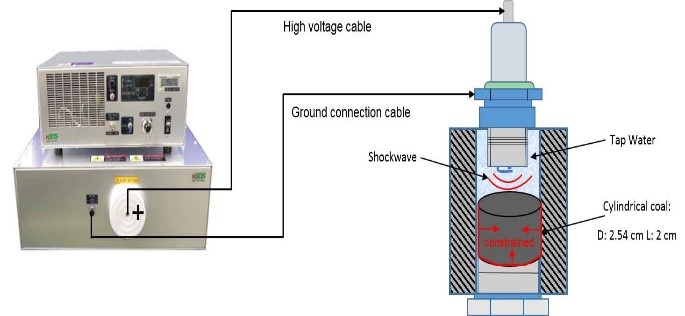
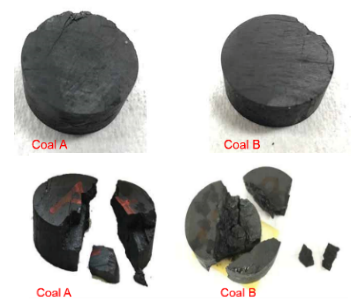
Biomedical engineering
Skin cancer and healing:
Our goal is to develop a plasma source capable of producing a reduction in bacterial load in environments that simulate the conditions existing in chronic wounds. This project would not incorporate clinical trials but focus on the development and pre-clinical testing of the prototype plasma source. This initial prototype would be targeted towards the treatment of chronic wounds, with in vitro testing of the prototype to determine the impact of the device on human cells and demonstrate the sterilisation effectiveness. In particular, studies would focus on investigating the DNA and ultraviolet radiation damage to evaluate potential future clinical device development.
Cochlear stimulation:
The UQ researchers have been working on applications of electromagnetic and pulsed power on Biomedical systems. The main goal is to study and investigate the impacts and applications of nanosecond pulsed power in hearing devices in collaboration with Augmented Bionics. The knowledge generated by this core area will provide a fundamental platform in Biomedical Engineering and applications – more especially, direct applications of pulsed power for cancer treatment or Bone stimulation and fracture healing.
Professor Firuz Zare
 Professor Firuz Zare is a Fellow of IEEE, Power Electronics Professor and a discipline leader of Power, Energy and Control Engineering at the University of Queensland in Australia. He received his PhD in Power Electronics from Queensland University of Technology in Australia in 2002. He has over 20 years of experience in academia, industry and international standardisation committees, including eight years in two large R&D centres working on power electronics and energy conversion systems.
Professor Firuz Zare is a Fellow of IEEE, Power Electronics Professor and a discipline leader of Power, Energy and Control Engineering at the University of Queensland in Australia. He received his PhD in Power Electronics from Queensland University of Technology in Australia in 2002. He has over 20 years of experience in academia, industry and international standardisation committees, including eight years in two large R&D centres working on power electronics and energy conversion systems.
Professor Zare has received several awards such as an Australian Future Fellowship, John Madsen Medal, Symposium Fellowship and early career excellence research award. He has published four books, over 280 journal and conference papers, five patents and over 40 technical reports. He is a Task Force Leader (International Project Manager) of Active Infeed Converters to develop the first international standard IEC 61000-3-16 within the IEC standardisation SC77A.
Professor Zare is a Senior Editor of IEEE Access journal, a Guest Editor and Associate Editor of the IEEE Journal of Emerging and Selected Topics in Power Electronics, Associate Editor of IET journal and an Editorial board member of several international journals. His main research areas are a) Power Electronics Topology, Control and Applications, b) Power Quality and Regulations and c) Pulsed Power Applications.
Dr Negareh Ghasemi
Dr Negareh Ghasemi received her Ph.D. degree in electrical engineering from the Queensland University of Technology in Australia in 2013. From 2013 to May 2018, she was a lecturer with the power engineering group, Queensland University of Technology. She is currently a lecturer with the School of Information Technology and Electrical Engineering, The University of Queensland, Australia. Her research interests include power electronics, energy conversion, pulsed power, and ultrasound systems and their applications. Dr Ghasemi secured several research funds (>$900k AUD) and designed and developed multiple energy conversion systems for different applications including high power and high frequency systems. Dr. Ghasemi is a senior member of IEEE society and a member of the editorial board of the International Journal of Power Electronics. Since 2012, she has been an active member of IEEE Women in Engineering group serving as Chair and Vice-chair of WIE group.
Dr MirHojjat Seyedi
Dr MirHojjat Seyedi received his PhD degree in Electrical Engineering (bioelectronics) from Victoria University, Australia in 2014. He was a research fellow at Tehran University of Medical Sciences, Iran in 2015 where he engaged in several image-guided surgery projects. In 2016, he joined the Department of Biomedical Engineering, Islamic Azad University, Iran as a faculty member (an assistant professor) for the duration of four years where he worked as a head of the department from 2019 to 2020. In 2021, he started collaborating with the Pulsed Power Group and the School of Food at The University of Queensland, Australia. He is currently working on a multidisciplinary bioelectrics project as a research fellow. Dr Seyedi is an IEEE senior member and collaborating with different scientific journals such as IEEE Transaction on Biomedical Engineering.
Explore Pulse Power and its applications across food processing, decontamination, mining and dewatering systems, and biomedical engineering and hear from world-leading energy researchers at the first Australian Pulsed Power Workshop (AusPPW).
Find more information on the workshop event page.
Get in touch
The pulsed power research group is led by Professor Tapan Saha.
Find us
Room 515, Level 5, Foxtail Building
Long Pocket Campus
The University of Queensland
80 Meiers Road, Indooroopilly (Map)
